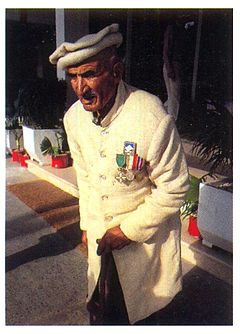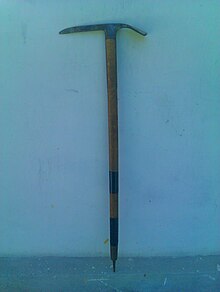Amir Mehdi

 Clash Royale CLAN TAG#URR8PPP
Clash Royale CLAN TAG#URR8PPP
 | |
| Personal information | |
|---|---|
| Nationality | Pakistani |
| Born | 1913 |
| Died | 1999 |
| Climbing career | |
| Type of climber | Mountaineer |
| Known for | 1954 K2 Ascent |
| First ascents | Nanga Parbat |
| Major ascents | K2 first ascent |
Amir Mehdi (sometimes spelled Amir Mahdi, and also known as Hunza Mehdi) was a Pakistani mountaineer and porter known for being part of the team which managed the first successful ascent of Nanga Parbat in 1953, and of K2 in 1954 with an Italian expedition. He, along with the Italian mountaineer Walter Bonatti, are also known for having survived a night at the highest open bivouac - 8,100 metres (26,600 ft) - on K2 in 1954.[1][2]
Contents
1 Nanga Parbat (1953)
2 K2 (1954)
3 Life and career
4 Awards and Titles
5 See also
6 References
Nanga Parbat (1953)

Ice Axe used by Amir Mehdi, during 1954's K2 ascent
In July 1953 a German-Austrian team went for expedition to Nanga Parbat. The expedition was organized by the half-brother of Willy Merkl, Karl Herrligkoffer from Munich, while the expedition leader was Peter Aschenbrenner from Innsbruck, who had participated in the 1932 and 1934 attempts. Hermann Buhl, one of team member made it to the top and became first person to reach the summit. He was assisted by two high altitude porters from Hunza, Amir Mehdi and Haji Baig. They later helped Buhl during his descent, when he was caught by frostbite and lost his crampon.[3]
K2 (1954)
During the Italian expedition, he and Walter Bonatti were stranded by Achille Compagnoni and Lino Lacedelli, who wanted to prevent Bonatti from reaching the summit, and were forced to huddle on an ice ledge overnight at 8,100 metres (26,600 ft), the highest ever open bivouac at the time.[1] As Mehdi was wearing standard army boots, he lost all his toes to frostbite and spent 8 months in hospital recovering from the ordeal.
It would later be revealed that Compagnoni had deliberately moved the camp because he wanted to prevent Bonatti and Mehdi from joining the summit bid. Compagnoni apparently feared that Bonatti, who was younger and fitter, would steal the limelight.
Unlike his Italian colleagues, Mehdi hadn't been given proper high-altitude snow boots. He was wearing regular army boots - according to some reports, they were two sizes too small for him. Inevitably, he suffered severe frostbite, and by the time he reached base camp he was unable to walk. He had to be carried on a stretcher to a hospital in the town of Skardu, where he was given first aid, and transferred from there to a military hospital in Rawalpindi.
Doctors had no choice but to amputate all his toes to prevent gangrene from spreading. He was only released from hospital eight months later.
When he finally returned home to his village in Hunza, Mehdi put away his ice axe and told his family he never wanted to see it again.[4]
Life and career
Amir Mehdi left mountaineering after the K2 attempt. He served briefly as a government servant of Pakistan. Amir Mehdi lived a modest life in his hometown Hassanabad for the rest of his years.
Amir Mehdi died of old-age in 1999, in Hunza.
Awards and Titles
- The Italian government awarded him the rank of cavaliere.[1]
- Amir Mehdi also received Italian civilian medal, Al Valor Civile.
- Amir Mehdi was given the title of 'Hunza Tiger' for the services rendered during the ascent of Nanga Parbat in 1953.[5]
See also
Nazir Sabir
Ashraf Aman
Samina Baig
Hunza Valley
References
^ abc "Amir Mehdi: Left out to freeze on K2 and forgotten". Retrieved 7 August 2014..mw-parser-output cite.citationfont-style:inherit.mw-parser-output qquotes:"""""""'""'".mw-parser-output code.cs1-codecolor:inherit;background:inherit;border:inherit;padding:inherit.mw-parser-output .cs1-lock-free abackground:url("//upload.wikimedia.org/wikipedia/commons/thumb/6/65/Lock-green.svg/9px-Lock-green.svg.png")no-repeat;background-position:right .1em center.mw-parser-output .cs1-lock-limited a,.mw-parser-output .cs1-lock-registration abackground:url("//upload.wikimedia.org/wikipedia/commons/thumb/d/d6/Lock-gray-alt-2.svg/9px-Lock-gray-alt-2.svg.png")no-repeat;background-position:right .1em center.mw-parser-output .cs1-lock-subscription abackground:url("//upload.wikimedia.org/wikipedia/commons/thumb/a/aa/Lock-red-alt-2.svg/9px-Lock-red-alt-2.svg.png")no-repeat;background-position:right .1em center.mw-parser-output .cs1-subscription,.mw-parser-output .cs1-registrationcolor:#555.mw-parser-output .cs1-subscription span,.mw-parser-output .cs1-registration spanborder-bottom:1px dotted;cursor:help.mw-parser-output .cs1-hidden-errordisplay:none;font-size:100%.mw-parser-output .cs1-visible-errorfont-size:100%.mw-parser-output .cs1-subscription,.mw-parser-output .cs1-registration,.mw-parser-output .cs1-formatfont-size:95%.mw-parser-output .cs1-kern-left,.mw-parser-output .cs1-kern-wl-leftpadding-left:0.2em.mw-parser-output .cs1-kern-right,.mw-parser-output .cs1-kern-wl-rightpadding-right:0.2em
^ "Bonatti e il K2, la vera storia". nationalgeographic.it. Retrieved 24 April 2017.
^ "Nanga Parbat - Rakhiot Flank - East Ridge - 1953". himalayamasala.com. 21 September 2013. Retrieved 24 April 2017.
^ Jillani, Shahzeb (2014-08-07). "Left out to freeze on K2". BBC News. Retrieved 2018-12-11.
^ Buried in the Sky: The Extraordinary Story of the Sherpa Climbers on K2's Deadliest Da. 2012. ISBN 9780393079883.
This Pakistani biographical article is a stub. You can help Wikipedia by expanding it. |